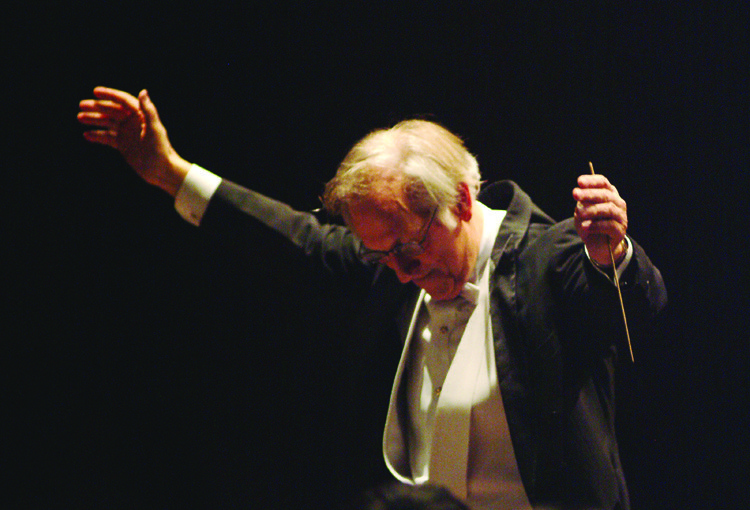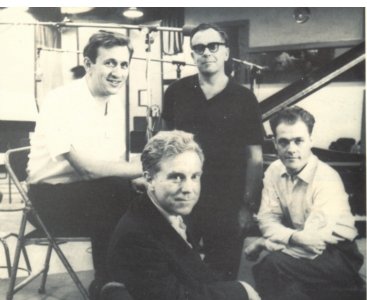
Soft-spoken, Swiss-born Gustav Meier looked the part of the maestro, with an elegant profile and silver hair that whipped to and fro on demand. But Meier, who died May 26 at 86, was an excited kid in the guise of a grey eminence.
Meier’s 27-year run as music director of the Lansing Symphony Orchestra, from 1979 to 2006, paralleled the papacy of Pope John Paul II, but Meier didn’t like to pontificate. Asked why he chose Tchaikovsky’s “Pathetique” symphony for his 2006 Lansing swan song, he just grinned and said, “Tchaikovsky turns me on.”
The conducting bug bit Meier while playing trumpet for the Biel Opera in Switzerland in 1951. He had no training as a conductor yet, but when the effervescent, order-out-ofchaos finale of Mozart’s “Marriage of Figaro” fizzed above his head, he resolved to climb out of the pit and delve holistically into the scores he loved. He enrolled as a conducting student at the Zurich Conservatory and never played trumpet again.
His career took an exotic side path in 1954, when was appointed court conductor for Emperor Haile Selassie I of Ethiopia. He quickly learned the valuable skill of making the best of a less than optimal ensemble. The “orchestra” was little more than a 15-piece brass band, but he crafted arrangements that made it sound big enough for opera.
One of Meier’s biggest unfulfilled goals in Lansing was to put on a full production of “Aida,” complete with elephants, at the Breslin Center.
“I was close to ‘Aida,’ because I did it for Haile Selassie and I felt like an expert,” Meier later said. “We couldn’t find the sponsors.”
In the mid-1950s, Meier moved to the United States and became a prize pupil of the star-studded 1958 conducting class at the Tanglewood Music Center that included iconic conductors Zubin Mehta and David Zinman.

He became the youngest conducting professor ever at Yale, in 1960, buoyed by recommendations from Aaron Copland, Milton Babbitt and Leonard Bernstein. After a 13-year stint at Yale, Meier served for three years at the Eastman School of Music and then accepted a position at the University of Michigan in 1976.
By 1979, Meier was based in Ann Arbor and established as one of the most soughtafter conducting teachers in the world. The Lansing Symphony was a serviceable community orchestra, holding its concerts in Everett High School’s auditorium. The conductor, Clyde Roller, was tired of commuting from Texas, where he was associate conductor of the Houston Symphony.
Kenneth Beachler, who has been involved with the Lansing Symphony since the 1960s, as board member and occasional performer, said Meier got the symphony “on a roll” after being in “stasis mode.” But there was some initial resistance.
The first meeting between Lansing Symphony board members and Meier took place in secret, at a highway rest stop between Lansing and Ann Arbor, Beachler said. Bringing a maestro from Ann Arbor into Spartan country didn’t sit well with some of the musicians and board members.
“We could see right away his standards for artistic excellence were high,” Beachler said.
Carol Kahn, then a member of the board and later president, was in the delegation that recruited Meier as music director.
“Gustav could charm the wallpaper off the wall,” Kahn said.
In Lansing, Meier had to draw on his experience in Ethiopia, making the best of a motley lot. He sometimes clashed with older players who viewed their positions as sinecures.
“There was a violinist of sorts,” Kahn recalled. “Gustav used to look at me and say, ‘I can’t stand it! We’re stuck!’ I don’t know how he finally got rid of her, but he did.”
“I was lucky because the orchestra was basically old,” Meier explained years later. “I had to replace a lot of people who retired.”
Meier was a magnet for fresh talent. With the symphony installed in the new Wharton Center in 1982, the scene was set for a crescendo of growth.
Principal flutist Richard Sherman, a nationally recognized musician who could write his own ticket in most American cities, said Meier’s cachet brought him to Lansing and kept him here.
“He had a child-like eagerness to delve into scores and create the best music he could,” Sherman said in 2013.
Besides his duties in Lansing, Meier was the music director of the Greater Bridgeport Symphony in Connecticut, near his first teaching gig at Yale. He reigned in Bridgeport even longer than he did in Lansing — 41 years, from 1972 to his retirement in 2013.
Despite his two impressive runs as maestro, Meier may have made his most lasting mark in music as a teacher. His students have gone on to lead orchestras around the world, and jazz vocalist and conductor Bobby McFerrin studied with him. A strong advocate for placing women at the top of American orchestras, Meier was ecstatic to see one of his students, Marin Alsop, named the first female maestro of a major American orchestra in 2007, when she was named music director of the Baltimore Symphony Orchestra. Another Meier student, Carolyn Kuan, became music director of the Hartford Symphony in 2012 and is frequently mentioned as one of the nation’s most exciting young conductors.
In 2015, Meier announced one last retirement — from the job that was dearest to him — director of graduate conducting at the Peabody Institute. Alsop succeeded him.
“I am heartbroken to lose him, but am intensely grateful for the many memories that remain,” Alsop said in a statement last week, “Alongside his insatiable curiosity and quiet ‘Swiss’ enthusiasm, that I will always cherish.”
Support City Pulse - Donate Today!
Comments
No comments on this item Please log in to comment by clicking here